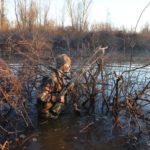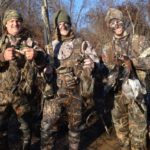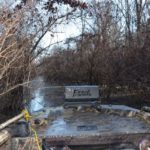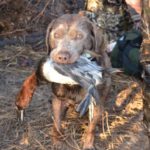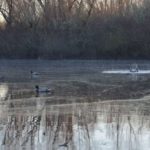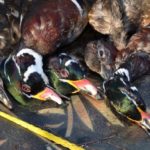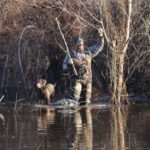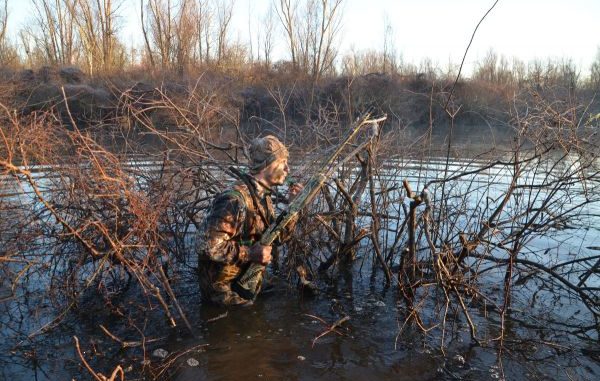
This wildlife management area might be better known for deer and squirrel hunting, but these men know there are also quick limits of ducks to be had.
The air was so cold it felt like icicles stabbing my lungs every time I inhaled. The Wilkins gang was launching their surface-drive boat off the Red River levee into a 1,200-acre greentree reservoir on Richard K. Yancey Wildlife Mangement Area.
Chuck, at 53 years old, was the Poppa Bear and the quiet one. Younger son Chad was a slender, 24-year-old chatterbox, and he would prove to be almost impossible to drag off the water until the men had their limit of ducks.
Twenty-six-year-old Brandon was broad-shouldered and muscular, and only a little quieter than his brother.
Both sons were athletic and energetic — perfect companions for a middle-aged man.
I had been looking forward to this hunt for a year. The big WMA, located in the rich alluvial soils at the confluence of the Red and Mississippi rivers, is famous for the number of deer taken from it, as well as the size of the racks on the bucks.
Richard K. Yancy WMA is also famous for the quality of its squirrel hunting, yielding big kills of coveted fox squirrels in both red and black color phases, as well as gray squirrels.
But waterfowl don’t usually come up in conversations about the WMA.
It was 3:50 a.m. when Chuck cranked up the boat’s motor. The men wanted to be sure that they got to their favorite spot before other hunters did.
Such is the world of public hunting — first come, first served.
Chuck quickly piloted the boat out of the open turning basin at the launch into one of several “trails” leading from the pond. The headlights mounted on top of the boat’s bow lit a tunnel through a dense world of buttonwoods overtopped by willow trees.
Because of the impenetrable woody brush, the boat couldn’t be run willy-nilly in just any direction. Trails had to be followed; they often forked, intersected each other or crossed open “ponds,” giving the impression of traveling through a maze.
The trio knew where they were going, though, and soon the boat popped out into a pothole of open water approximately 75 by 100 yards.
They set their decoys in two loose groups: six mallards in one and six wood ducks in the other.
At different points, they set two drake pintail and one drake mallard Wonderduck Super Twister Motion Decoys. The Wonderducks swam in circles, gaily flipping water 4 feet in the air.
In the still water of the sheltered potholes, you really need the motion of the Wonderducks, Chad explained.
“But,” he added, “it really doesn’t matter how you place the rest of your decoys.”
With the decoys in place and the boat hidden by 4:45 a.m., it was going to be a long, cold wait until shooting hours.
Cramped, too.
Four adult men were clumped on a table-sized hummock of land sticking out of the water. They were joined on their refuge from the cold, crotch-deep water by Chuck’s silver Labrador retriever, Ben, and Chad’s chocolate lab, Remi.
It was a long, miserable wait. The air was so cold it seemed to crackle.
We couldn’t even move around to keep warm on the tiny mound of dirt. In desperation, Chuck twice tried to build a fire using toilet paper and soggy sticks —to no avail.
Finally, shooting light approached and the two younger men left the little hill to triangularly cover all angles of the pond.
They hunted the rest of the morning in knee- to crotch-deep water.
With the light came the ducks.
Weenk, weenk, weenk, squealed passing groups of wood ducks.
“Weenk, weenk, weenk,” replied the men on their wood duck calls.
At exactly shooting time, the pothole exploded in gunfire.
Blinds weren’t necessary: The hunters simply stood in the water, nestled into brush surrounding the hole.
The shooting was hot and heavy for a half hour. Between bursts of shooting, the brush echoed with dog commands.
“Back. Dead bird. Back, back.”
Ben delivered a crippled woodie to Chuck, who promptly wrung its neck.
“I tried that Phil Robertson thing once,” he muttered through his face mask. “You know — biting its head.
“But I bit too hard and tasted brains.”
Quickly, two limits of wood ducks were down on the water.
Then, passing birds became skittish and avoided from the hole.
“They’re flaring,” Chuck yelled to his sons. “You reckon I ought to go pick up them wing-things?”
“I’ll go move some decoys,” replied Chad.
“You know what’s going to happen, sure enough,” Chuck grunted.
It did.
With Chad in the open, a flock of big ducks — probably gadwalls — a lone flyer and then a flock of wood ducks buzzed the pothole, one behind the other.
They only bagged the lonesome single, which quickly bit on a mallard comeback call.
The reason for its gullibility became obvious after it was sent crashing with a single shot.
It was an odd duck — a beautiful drake canvasback, not the wariest duck in the world and the last thing one would expect to pick up in a pothole in the woods.
The last of their birds came quickly.
After checking out at the WMA’s self-clearing permit station, conveniently located on Highway 910 about 200 yards from its junction with Highway 15, the happy men headed to the camp for breakfast.
It was still too early for brunch.
